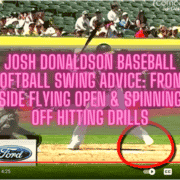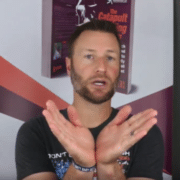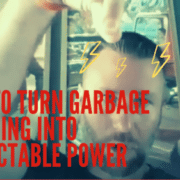David Weck RMT Club Youth Power Program Review For Baseball, Softball, Pitchers, Golf, & Runners | Best In & Off-Season Strength Training Exercise Workout Plan For 10 Year Olds AND College Players
Learn about David Weck and the RMT Club youth power program in this interview review for baseball, softball, pitchers, golf, and runners. Discover the best in-season and off-season strength training exercise workout plan for 10 year olds up to college athletes.
David Weck Interview: More Speed, Control, & Power With LESS Wear And Tear On The Body
You asked for it!
I had quite a few of my readers ask me about the WeckMethod of training by David Weck. Btw, David is the inventor of the Bosu Ball, for those that train athletes for a living. And the readers who kept bringing up his training referred to his new product the RMT Club
, which you’ll learn more about in the above interview.
If you’ve never heard about the WeckMethod of training, and want to know what sets it apart, please CLICK HERE to view the following 35-min video.
If you’re short on time, then here’s a brief introduction to the WeckMethod of training from David Weck:
“What I do is more fundamental foundational work than specific hitting instruction. My focus is improving systemic strength and power concentrating on Tensional Balance and Rotational Power – as well as non-dominant side training to provide a stronger foundation for sport specific skill.”
I feel like he’s onto something that most trainers ARE NOT. And it’s because he understands the foundation of locomotion. He has a fantastic understanding of the human movement “rules”.
SCIENCE-BASED TRAINING:
Improve your hitting strategy dramatically by applying human movement principles.
Learn not only how and what to train but also the science behind the methods.
In my research, I fell into the following David Weck Carpool Tunnel fix video that helped get rid of the pinching in my right wrist, at the bottom of a push-up position, in about a week (I haven’t been good lately with my gymnastics wrist stretches 🙁:
Another great article I ran into in my research – and posted to social media – was an interview that Chris Holder did at BreakingMuscle.com with David Weck titled, “The Key To Speed Is In Your Spine” There are great nuggets in there along with a few training videos. It’s definitely worth your time.
The main video above is a Skype interview I did with David Weck that’s about 45-minutes. A lot of great information in there that translates to hitters and HOW TO train power. What follows are some of those talking points…
The Show Notes
- How would you explain to a complete stranger what it is that you do? (1-min, 22-seconds)
- DW explains Tensional Balance – relationship between suspension and transmission throughout your body, requires perfect alignment of skeleton, muscles, and connective tissue (1-min, 48-secs)
- When tensional balance & rotational power are dialed in, you can express more speed, control, power, etc. with LESS wear and tear on the body (3-mins, 10-secs)
- Where did DW’s passionate curiosity into this realm of training come from? (4-mins, 20-secs)
- DW discovered slow motion analysis while playing D3 college football – you cannot understand human movement with that slow frame by frame motion analysis, the eye in the sky does not lie…clock doesn’t lie…measuring tape doesn’t lie (6-mins, 0-secs)
- Unmatched degree of intensity to enhancing human locomotion because of Bosu Ball success…was able to devote entire focus to seeking and finding answers. (7-mins, 23-secs)
- Deep appreciate that locomotion is the key, developing straight ahead speed, is the key to developing the greatest rotational power (9-mins, 0-secs)
- Human movement industry is about to be flipped on its head because of this breakthrough understand of “core” strength…the “Bracing Core” (weight room and picking up heavy objects) versus the “Coiling Core” (engaging in lateral movement – side bending and head over foot) (9-mins, 40-secs)
- Real versus Feel coaching, “My athletes are doing something that I’m not coaching them to do”, high level athletes have an innate sense of speed and power, but coaches are trying to coach it out of them, elite athletes (like Olympic Gold Medal winning sprinter Michael Johnson) saying to do the exact opposite of what they’re doing on film! Experts are teaching on a faulty foundation (11-mins, 40-secs)
- DW is meeting with Marlon Byrd on getting specific with the WeckMethod exercises (14-mins, 7-secs)
- Quick movement experiment…stand up right now and going through a throwing motion WITHOUT any side bending…how did that feel? Without side bend you’ll destroy your spine. You can train side bend. Locomotion is your foundation. (17-mins, 50-secs)
- DW responds to the reader comment, “Is it logical to say that average kids can perform at a tier-1 level?” In context, the reader comment was to the claim that my 100-lb hitters consistently driving the ball 300-feet are standouts athletically. Also, what makes a kid athletic? (20-mins, 10-secs)
- DW explains how to train ipsilaterally (right shoulder-right hip) to get the “Serape Effect” or I like to call the “Springy X Pattern” (right shoulder-left hip) optimized for performance. Tighten the coil, time the sequence, and keep center of gravity to be neutral. Take clunky and make them fluid. (22-mins, 20-secs)
- DW discusses the curse of moving the center of gravity during rotation. Learning the axis of rotation, front/back, and side. Central control. Create a late rotate, like a whip. (25-mins, 0-secs)
- The evolution of the spine, side bending is crucial to an S-shaped spine curve. (27-mins, 30-secs)
- DW responds to the question, “Does sprinting, throwing, hitting start from the ground up? Why or why not”. CLICK HERE for the HPL link I referred to in the video (33-mins, 30-secs)
- DW talks about harmonizing the muscles with the connective tissue. Least muscular contraction compared to the connective tissue. Muscles that are bound up, cannot relax. Transmission of force, power equals speed. Muscle acts like a circuit breaker. (34-mins, 0-secs)
- DW discusses having tensional integrity between the muscles on the inside, and fascia on the outside. How integrity and connected the fascia is to muscles. Bonds never lost body-weight transmission when he bulked up. Strong is great, but not at a sacrifice of speed. (37-mins, 0-secs)
- We discuss Thomas Myers, Anatomy Trains, “finger flick” test to demonstrate the power of connective tissue over muscle contraction (38-mins, 44-secs)
- DW responds to the question, “If you were going to prescribe 2 of your top RMT Club exercises to a baseball or softball player, what would they be?” Coiling Head Over Foot movement. Pulse of power. (39-mins, 30-secs)
- DW top gifted books: Thomas Myers book Anatomy Trains
, Jim Piersall book Fear Strikes Out: The Jim Piersall Story
(44-mins, 0-secs)
Recommended Top RMT Club Exercise for Baseball or Softball Players
CLICK HERE for a link to his blog to supplement this video.
Where can you find more about David Weck and the WeckMethod?
- Website: WeckMethod.com
- Facebook: /WeckMethod
- Twitter: @weckmethod
- Instagram: @weckmethod
- YouTube: user/weckmethod
- LinkedIn: company/weckmethod
- Pinterest: /WeckMethod
- Google Plus: https://plus.google.com/
+Weckmethod
- Fix Your Child’s Fear of the Ball Fast: Proven Hitting Drills to Stop Flinching at Pitches—Trusted by Top Youth Baseball Coaches - July 12, 2025
- Fix Your Little Leaguer’s Hitting Slump Fast – Proven Confidence Drills & Mental Reset Tools (Used by Top Youth Baseball Coaches) - July 9, 2025
- Best Hitting Drills for 8-Year-Olds (2025): Fix Swing Flaws Fast with This MLB-Trusted Youth Baseball System—At-Home, Step-by-Step, and Built for Game-Day Confidence - July 5, 2025













Sorry guys, my site temporarily went down today because of an updated site plugin, and I had to revert to a backup version of my site from yesterday, so the comments some of you took the time and effort to submit got deleted 🙁 I apologize.
Nice article Joey…i hope you read my comments…I’ll not repeat them as they were lengthy….lime always… I think i had some interesting thoughts… again… this is by far one of your most important articles….
Thanks. Hope all is well…
?
~DM
Djura, sadly I didn’t get to read all of yours or the four other reader comments before they were deleted 🙁 I apologize brother, and do value what you have to say.
Wow! Another great article. Yes, please do a part 2 interview. Looking forward. Great information. Thank you
I think that would be good too. In four weeks I’ll publish a Zepp swing experiment going through WeckMethod programming. So curious to see how it benefits the swing.
Joey- do you see any issues with training with the RMT club for younger players? 10-12 yrs old, not physically developed yet…
No issues Matt. The clubs are light in weight, and there weights ranging from three to six pounds I believe. You can also use a split grip (gap between hands) with them to lighten the “feel” load. They’re meant to be lighter because power is moving weight quickly. And as an added bonus, the RMT Club fortifies the eccentric muscle contraction (aka the “negative”), which is where a majority of injuries occur.
Joey, What do you think of the shoulder to hip in the same side connection that was referenced…. first, why stop at the hip….The funny thing about side bending is you can preset it and look like your standing tall…. but if you turn (either way), you should always follow your plane no matter what it looks like….If it’s preset, than it’s ready to go but just needs a little touch… perhaps a pinch…?
Do you see where I’m going? I hope so…
It looked like I made your guest biggest move into a first trigger(Go) move….It obviously does more and is really complicated….
Question ???? Can we coordinate our side bending… assuming we can, than are we just leaning in to get rotation…leaning in similar to catching a ball at 1st…assuming we have an angle than all we do is let go to the ball… meaning gravity and our eyes do its thing…Ok if I sound like I’m from MARS… I understand…
Any thoughts are appreciated… later hope all is well…
~DM
Djura, it should also be noted David said the Serape Effect (contralateral – opposite shoulder and hip) is what happens before rotational movement, or like I call the Springy X Pattern, but said to train that it’s ipsilateral movement (same side hip and shoulder) side bending that unlocks rotation. And I agree. I think David is stopping at the hip because of spinal engine mechanics relationship between pelvis, spine, and shoulders. And you’re correct, you can preset the position before starting the swing, and it’s still effective. The difference in presetting and moving into the pre-loading position would be: Dustin Pedroia (late), Miguel Cabrera (during), and Hunter Pence (early).
Not sure if that answered your question.
Great models… I was trying to say he stops at the hip but I would go further in the baseball swing where we pick up our lead foot and put it down…How bout this if you follow me…how do we get our lead foot down… meaning what actually gets it down… my thoughts a direct first go move… Obviously if your fooled we can adjust meaning letting the foot down but not switched if that makes sense…I think that the lateral meridian lines play a roll too in combination with the arm lines… while the functional lines do its thing if we are positioned correctly…Any thoughts…
So my thoughts are to preset with his thoughts but than to preset that preset with the lateral and arm lines… and why… we’ll if it’s all there than all we do is use our eyes, ???? and ????
Notice the two sets of question marks…
Assuming I’m right of course!!!Hope all is well..What say you?
~DM
By the way, when you say unlocks rotation and its prior to rotation… your confusing me…. how can we unlock something that hasn’t happen… unless your seeing it my way which is it’s all ( well not all, I’ll know I’ll get caught for something) preset… in order words, the shoulder to hip connection is HOLDING ( sorry for the bold) the rotation and as such must have happened after rotation… if that’s the case, we are hitting the ball prior to neutral meaning… we are hitting the ball in the load phase….
And if we are holding… than touching (measuring) the ball with our left and letting go of our punch ( I know you don’t like that cue) with our right … those are just triggers…Controlling what is already done… the swing…Just ready to go…
~DM
Joey…..Please don’t think I’m trying to argue just to argue…or that I’m arguing…Im really just trying to have a discussion…and I’m just trying to add what was already noted in terms of how I see it which may be wrong…
For me one of the biggest things ( of many) is the culture of baseball… if we agree with Thomas Myers than the arm lines can control just about everything…. but than we ignore it when applying that fact… the feet too… if we say shoulder to hip, perhaps it’s best to put those terms in meridians… so which fascia lines would we be considering and than we can try to see the bigger picture by that I mean where do those line end or start…
The baseball swing is difficult because we have both hands on the bat but that should not change our approach…. The fact is, I’m assuming now, having both hands on the bat lets us load even more…
Also, knowing what is real connection… as there is fake connection just like there is fake dosiflexion to some extent… yep here I go again….I would stay away from the functional lines unless they are not aligned correctly in which just look at the feet, especially the big toe… later… I’ll stop now unless you want to continue this discussion… later…
~DM
Another excellent article, just discovered it. Did you ever do the Part 2 interview with David Weck?
Do you have a promo code with WeckMethod to use for purchase of the RMT Club?
Thanks, Joey.
Hey Mike, glad you found the David Weck post. At this time I don’t have a part 2 but may do something soon with him. And also at the moment I do not have a coupon code, but as Thanksgiving and Christmas approaches one may come up 😉